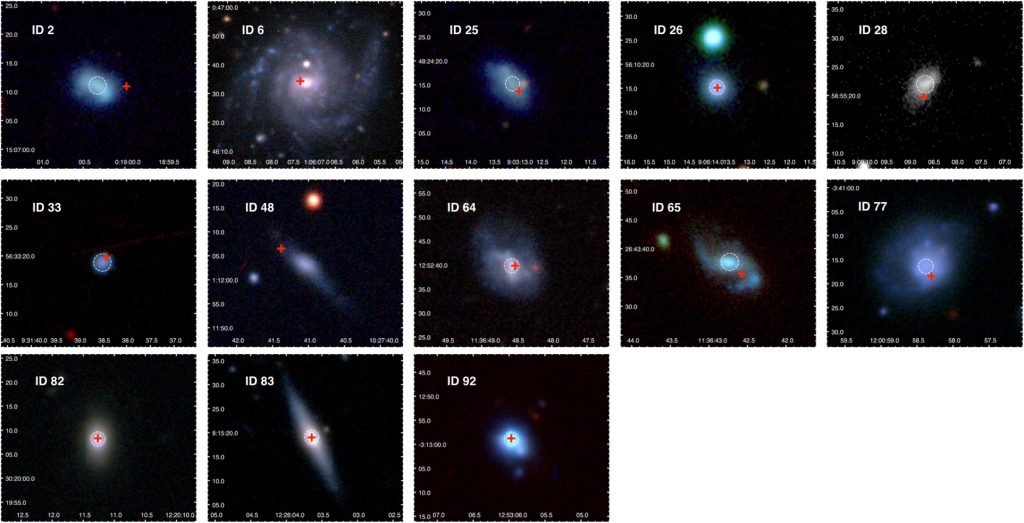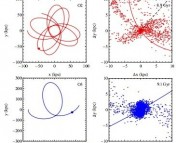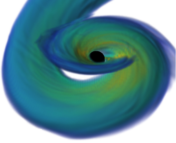Title: The Origins of Off-Center Massive Black Holes in Dwarf Galaxies
Authors: Jillian M. Bellovary, Sarra Hayoune, Katheryn Chafla et al.
First Author’s Institution: Department of Physics, Queensborough Community College, City University of New York, 222-05 56th Ave, Bayside, NY, 11364
Status: Submitted to MNRAS. Open access on Arxiv.
Overly strong dwarfs
It is well known that in the cosmic world massive large-scale objects tend to be more powerful. For example, massive galaxies are often hosts of supermassive black holes. However, recent observations have discovered that dwarf galaxies can host very massive black holes (MBHs) as well! While dwarf galaxies weigh less than 1% of our Milky Way, they can host black holes as massive as ~105 solar masses.
Although many small infant galaxies and black hole seeds exist in the high-redshift universe, we are unable to directly observe their growth and formation due to their low brightness and distant location. However, it is still possible to get some clues on these mechanisms by studying nearby dwarf galaxies. For example, the small black holes in these dwarfs represent the low-mass end of scaled relations (e.g., black hole mass – stellar velocity dispersion), which indicates unique correlations between black holes and their host galaxies at early stages before they grow into giants. This is particularly extraordinary, as these dwarf galaxies are likely to host more than one black hole!
Recent VLA observations found a new sample of MBHs in 13 nearby dwarf galaxies (Figure 1). Among these MBHs, half are off-axis (defined as further than 400 pc away from the galactic center) and many are “wandering” in the outskirts of their host galaxies. This discovery changes the typical assumption that massive objects like black holes are always found in the center of their host galaxies due to gravitation.
Does this mean that almost half of MBHs in dwarf galaxies are off-center? In today’s paper, the authors use theoretical simulations to test this prediction.

When MARVEL meets DC…
To reproduce the dwarf galaxies we see today, the authors adopt two sets of hydrodynamical simulations with different volumes and cosmology assumptions: MARVEL-ous Dwarfs and DC Justice League. In both sets, the authors first set a cool environment with low molecular gas density for stars to form and grow. They then allow black hole seeds to be naturally formed through direct collapsing when their mass is over the Jeans mass in dense regions. After the black hole seeds are formed, they grow by merging into one another and continue accreting the surrounding gas.
In the beginning, most black holes form in the center of the galaxies naturally . As time goes by, dwarf galaxies encounter their neighbors. The smaller ones are tidally stripped, losing their stellar materials to their more massive neighbors. Although two galaxies can easily merge into one new dwarf galaxy, the two central black holes do not follow the same pattern. After losing their original home, the smaller black holes tend to stay in the outer region of the new merged galaxy, while the bigger black holes become the new centers. As a result, dwarf galaxies with wandering black holes are formed. This process is demonstrated in Figure 2.

From the simulations, the authors find that ~50% of the MBHs are off-center, which is consistent with previous observational discoveries. Moreover, these off-center MBHs have lower mass but are hosted in dwarf galaxies with larger stellar masses, which is a direct result of this merging process.
A Lifetime of Wandering
So is it just a matter of time for the wandering blackholes to finally find their way to the central region? The simple answer is no.
After merging, the galactic nuclei do not form gravitational wells deep and strong enough to quickly pull the wandering MBHs to the centers. It takes longer for most off-center MBHs to get back to the centers than a Hubble time – the time for the Universe to expand to its present size after the Big Bang at an unchanged rate (the Hubble constant). More surprisingly, mergers that are formed more recently can cause MBHs to move even further away from the centers. In other words, as MBHs start wandering in their host galaxies, most of them will stay in this way for a lifetime.

Given the large fraction of the off-center MBHs contained in dwarf galaxy systems, it is important to observe them for further study. However, these MBHs only live in the outskirts where the surrounding gas is diffuse. Therefore, off-center MBHs have very low accretion rates, resulting in very low luminosity. Figure 3 shows the growth of an off-center MBH in the simulations. However, it is still possible to find MBHs indirectly through the spectra and dynamics of surrounding nuclear clusters and bright stars (e.g., tidal disruption events).
In summary, the authors of today’s paper use two sets of hydrodynamical simulations called MARVEL-ous Dwarfs and DC Justice League. These simulations support previous observational results and suggest that almost half of MBHs in dwarf galaxies are off-center by. By expanding the sample size and increasing stellar densities in future simulations, the authors may be able to better predict the detectability of these wandering MBHs and provide more insights to observations.
Astrobite edited by Abygail Waggoner
Featured image credit: Sophia Dagnello, NRAO / AUI / NSF




